Civil Harassment Restraining Order
A Civil Harassment Restraining Order (CHRO) is an order directing a person not to harass or engage in violence against you. In Sacramento, CHROs are filed at the Gordon D. Schaber Sacramento County Courthouse, located at 720 Ninth Street, in downtown Sacramento.
Templates and Forms
You may seek protection if you are worried about your safety because you are being stalked, harassed, sexually assaulted, or threatened by someone you do not have a family or past or present romantic relationship with, like a neighbor, co-worker, or roommate.
Restraining order requests must be filed in person by the person requesting the order or by their attorney.
Step-by-Step-Instruction
1
Preparation
In order to complete the forms necessary to obtain a civil harassment restraining order, you will need to gather:
- The name and physical description of the person you want restrained.
- Any information you need to describe the last few instances of stalking, harassment, violence, threat, or sexual assault against you, including what was said and done and the names of any witnesses.
If the person you want restrained does not know your address, you may want to obtain a separate mailing address, such as a P.O. Box, to use on your court papers.
2
Complete the Necessary Forms
Sample filled-in forms with instructions are available at the end of this Guide. You have three options for filling out forms:
By hand:
The Sacramento County Superior Court has created a Step 1 Packet, which includes each of the necessary forms. The forms in packet are not fillable; you will need to print the packet and complete the forms by hand.
Typed:
To type the forms on a computer, download fillable forms from the California Courts website. See the packet listed above to determine which forms you will need.
Guided on the computer:
The Sacramento County Superior Court’s website provides access to Law Help Interactive (scroll down and click “Get Started” button), which will ask you a series of questions and use your responses to complete all the required forms. You will need to print the forms out to file them once you finish.
After you have completed all your forms, make one photocopy of each document.
3
Organize Your Papers for Filing
The court is very particular about the format and order in which you give the clerk the forms. When you file, the court will require the original of each form on top (unstapled), plus one copy underneath it (stapled).
Stack your forms in this order:
- Request to Waive Court Fees (FW-001)
- Civil Case Cover Sheet (CM-010)
- Request for Civil Harassment Restraining Orders (CH-100) plus two copies (total of three)
- Staple each copy, then clip behind original.
- Notice of Court Hearing (CH-109)
- Temporary Restraining Order (CH-110) (complete items 1, 2, and 3 only)
- Confidential CLETS Information (CLETS-001)
- Civil Harassment Restraining Order After Hearing (CLETS-CHO) (CH-130) (complete items 1, 2, and 3 only)
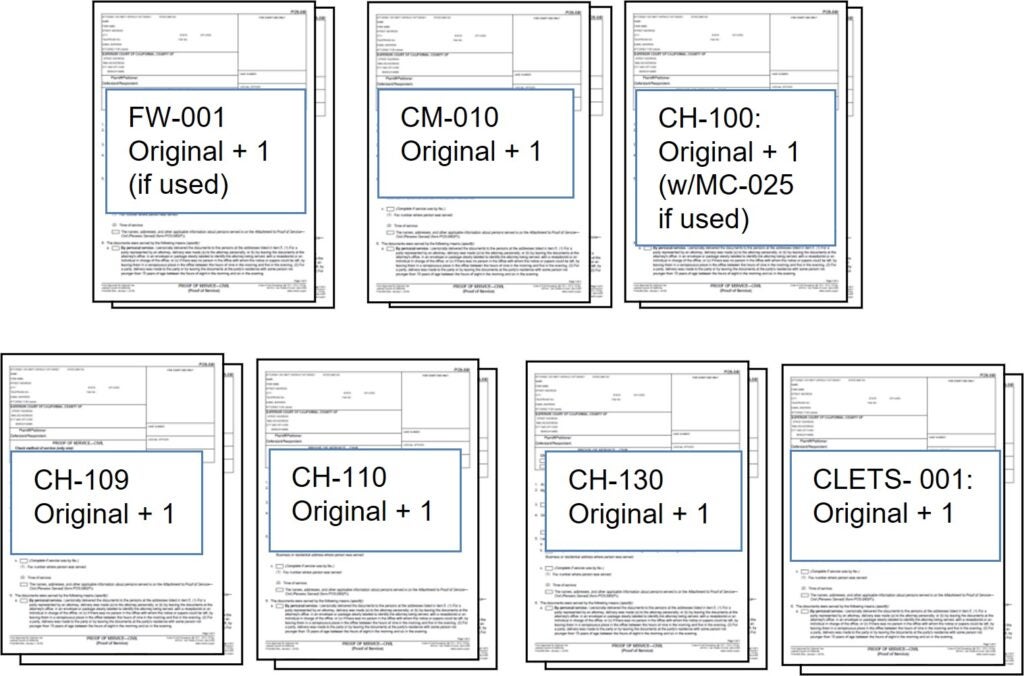
4
File your Papers
Restraining order requests must be filed in person by the person requesting the order or by their attorney. You will make two trips to the courthouse, one to turn in your request, and another to pick up your forms and ruling after it has been reviewed by a judge.
If you file before 11:30 a.m.: forms ready at 4 p.m. the same day. If the clerk accepts your forms by 11:30 a.m., you will receive your forms and ruling on any request for a temporary order at 4:00 p.m. the same day in the lobby outside Room 102 (720 9th St.).
If you file after 11:30 a.m.: forms ready at 4 p.m. the next business day. If you do not meet the 11:30 a.m. deadline, but your forms are filed before 4:00 p.m., you can pick up your forms and ruling on any request for a temporary order at 4:00 p.m. the next court business day in the lobby outside of Room 102 (720 9th St.).
Filing Fees: If your Request for Civil Harassment Restraining Orders (CH-100) form alleges violence, threats of violence, or words or acts that cause you to reasonably fear violence from the person you want restrained, there is no fee to file. You make this allegation by checking item 13 on your Request for Civil Harassment Restraining Orders (CH-100). However, if the Judge decides that your allegation is not credible, you must pay the filing fee when you pick up the forms at 4 p.m. The filing fee is currently $435.
If you are not alleging violence, but cannot afford to pay the filing fee, you may apply for a fee waiver at the time you file your restraining order papers. If you are submitting a fee waiver request, the clerk will accept your forms at the window when you file and you will not have to pay a filing fee at that time. However, if the Judge decides that you do not qualify for a fee waiver, you must pay the filing fee when you pick up the forms at 4 p.m.
For more information and sample fee waiver forms, see our fee waiver guide.
5
Examine the Papers for Orders and Hearing Date
When you pick up your papers, examine them carefully. A case number will be stamped on your documents. If the judge made temporary orders, they will be on the Temporary Restraining Order (CH-110), in paragraphs 5 through 8.
Review the Notice of Court Hearing (CH-109). Your hearing date and the court department that will hear your request for a permanent restraining order will be listed in paragraph 3.
The court clerk will enter the temporary orders into the California Restraining and Protective Order System (CARPOS) through the California Law Enforcement Telecommunications System (CLETS).
6
Service on the Person You Need Protection From
Have the following documents served on the respondent at least 5 days prior to the hearing date:
- Request for Civil Harassment Restraining Orders (CH-100) (and Attachment (MC‑025), if used)
- Notice of Court Hearing (CH-109)
- Temporary Restraining Order (CH-110) (if granted)
- Handout and blank documents in the Step 2 Packet
You can have the Sheriff’s office, a process server, or anyone over the age of 18 who is not a party in the case serve the person to be restrained. They must personally serve the paperwork on the respondent.
The person who serves the forms must fill out Civil Harassment Proof of Personal Service (CH-200) and return it to you.
If you cannot get the person you want restrained served in time for the hearing, you can request an extension of time. See the Sacramento County Superior Court’s packet for forms and information.
If the person you want restrained is avoiding or evading service, or cannot be located, see “What If the Person I Want Protection from Is Avoiding (Evading) Service or Cannot Be Located?” (form CH-205-INFO)
7
File the Proof of Service in Court
File the original and two copies of the signed Civil Harassment Proof of Personal Service (CH-200) form with the court. If you had the Sheriff serve the paperwork, the Sheriff’s office will file the Proof of Service with the court for you.
If you cannot file before the hearing date, bring the original and two copies with you to the hearing.
8
Review the Response, If Any
The person to be restrained may choose to oppose your request for a restraining order in writing. If so, they should mail you a copy of this response prior to your hearing date. Be sure to review any response so that you may anticipate any evidence the person you wish to be restrained will present in court.
9
Attend Your Hearing
Be prepared to spend at least half a day at the courthouse on the day of your hearing. Arrive at your assigned department early and wait for the courtroom to open. The calendar of cases to be heard that day will be posted next to the courtroom door. Make sure that your case is listed on the docket, and when the courtroom opens, check in with the court attendant.
Clear and Convincing Proof
A petitioner seeking a Civil Harassment Restraining Order must prove the matter by “clear and convincing proof,” meaning the petitioner must prove his or her facts in the case to be “highly probable.”
This is a higher standard of proof than most lawsuits, including Domestic Violence Restraining Orders. In most lawsuits, cases must be proven by “preponderance,” that is that the petitioner’s case must be proven to be more likely than not true.
Whether or not the other side appears, you will need to present your case to the judge. Be prepared to explain clearly and concisely why the court should grant your request. During the hearing, it is your burden to prove to the court by “clear and convincing evidence” the violence, threats, stalking, or harassment you claim. Be sure to bring any documents or photos that you will need to prove your case, such as medical or police reports, or threatening letters and emails. Witnesses may also bolster your case, but the court may or may not let witnesses speak at the hearing.
If the other side appears, they will also have an opportunity to present their side of the story. Do not be surprised if the judge interrupts either or both of you to ask questions. The judge is attempting to learn what happened, and is asking questions to assist him or her in understanding the situation.
At the end of your hearing, the judge may:
- grant your request;
- deny your request;
- take the matter under submission (think about it and mail their decision);
- continue the hearing to another date; or,
- refer you to mediation.
If your request is continued to another date or taken under submission, be sure to ask the judge to continue the temporary restraining order until to the new hearing or until you and the person you wish to be restrained can be notified of the decision.
If you do not attend your hearing, your request for a restraining order will be denied, and any temporary orders will expire.
10
Mediation
The judge may refer your matter to mediation. If this happens, you and the other party will meet with an available mediator, who will explain that mediation is both voluntary and confidential, and does not jeopardize either party’s ability to have a hearing – at any point either of you can say mediation is not working and you would like to request a hearing. In that case, both parties must return to the courtroom and wait until the judge is ready to hear the case.
The mediator does not make judgments and typically does not even look at the parties’ evidence. Rather, the mediation process focuses on what the parties can agree to do to make life peaceful in the future. The goal of mediation is to reach an agreement, which can include a restraining order. The mediated agreement is an enforceable stipulated judgment; the civil harassment restraining order case is dismissed. If either party violates the terms of the stipulated judgment, the other party can re-file the civil harassment restraining order case.
The benefit of mediation in a civil harassment restraining order case is that the person who wanted the restraining order can walk away from court that day with some sort of resolution in place, as opposed to often walking away with nothing. The court can only grant or deny a request for a civil harassment restraining order; because of the high “clear and convincing” standard of proof, the Sacramento County Superior Court grants few civil harassment restraining orders. Also, because the mediated agreement can be tailored to meet both parties’ needs, there is a higher likelihood of follow-through on both sides.
11
Court Enters CHRO into Law Enforcement Database
If a restraining order is granted, the court clerk will enter the order into California Law Enforcement Telecommunications System (CLETS), a statewide database of protective orders, via the California Restraining and Protective Order System (CARPOS).
12
Serve the Restrained Person
Follow the directions in Paragraph 13 of the Civil Harassment Restraining Order After Hearing (CH-130).
The judge will indicate if the orders must be served. If service is required, the judge will indicate if service may be done by mail, or if personal service is required.
If paragraph 13(b)(1) is checked, service by mail is permitted. Someone over the age of 18 who is not a party to the case may mail a copy of the signed CH-130 to the restrained person. Your server will complete Proof of Service by Mail (CH-250).
The sheriff is one inexpensive option to serve the papers. If you have the sheriff serve any paperwork, you must fill out the Instructions to Sheriff – Temporary/Permanent Restraining Order form.
If paragraph 13(b)(2) is checked, personal service is required. Your server must personally serve a copy of the signed CH-130 to the restrained person. Service must be performed by a sheriff, marshal, process server, or someone over the age of 18 who is not a party to the case. Your service will complete Civil Harassment Proof of Personal Service (CH-200).
13
File the Proof of Service in Court
File the original, plus two copies, of Civil Harassment Proof of Personal Service (CH-200) or Proof of Service by Mail (CH-250) completed in Step 12.
For help
Civil Self Help Services (Hall of Justice)
813 Sixth St., Sacramento CA 95814
916-874-1421
civilselfhelp@saccourt.ca.gov
Civil Self-Help Services (SHS) helps people without lawyers who have questions about simple issues related to a civil case. They can give you general information and help you prepare your own forms in the area of civil law. Common topics include civil harassment restraining orders, petitions for change of name/gender, and expungement of criminal convictions.
Sacramento Mediation Center
The same organization that conducts mediation in civil harassment restraining order cases at the Sacramento County Family Relations Court, the Sacramento Mediation Center charges fees on a sliding scale according to income.
Civil Bureau, Sacramento County Sheriff’s Department
2969 Prospect Park Drive, Suite 200
Rancho Cordova, CA 95670
916-875-2665
The Sheriff’s Civil Bureau can serve your papers for you for a fee. If you have a fee waiver, there is no charge.
For More Information:
California Courts Online Self Help Center (Civil Harassment)
This is the official website of the California Courts. It offers explanations and links to the forms you need for civil harassment restraining orders, and other types of restraining orders such as domestic violence, elder abuse, and workplace.
Samples
Yellow highlights show text that is always required. Other areas may or may not apply in your particular case.
Request for Civil Harassment Restraining Orders
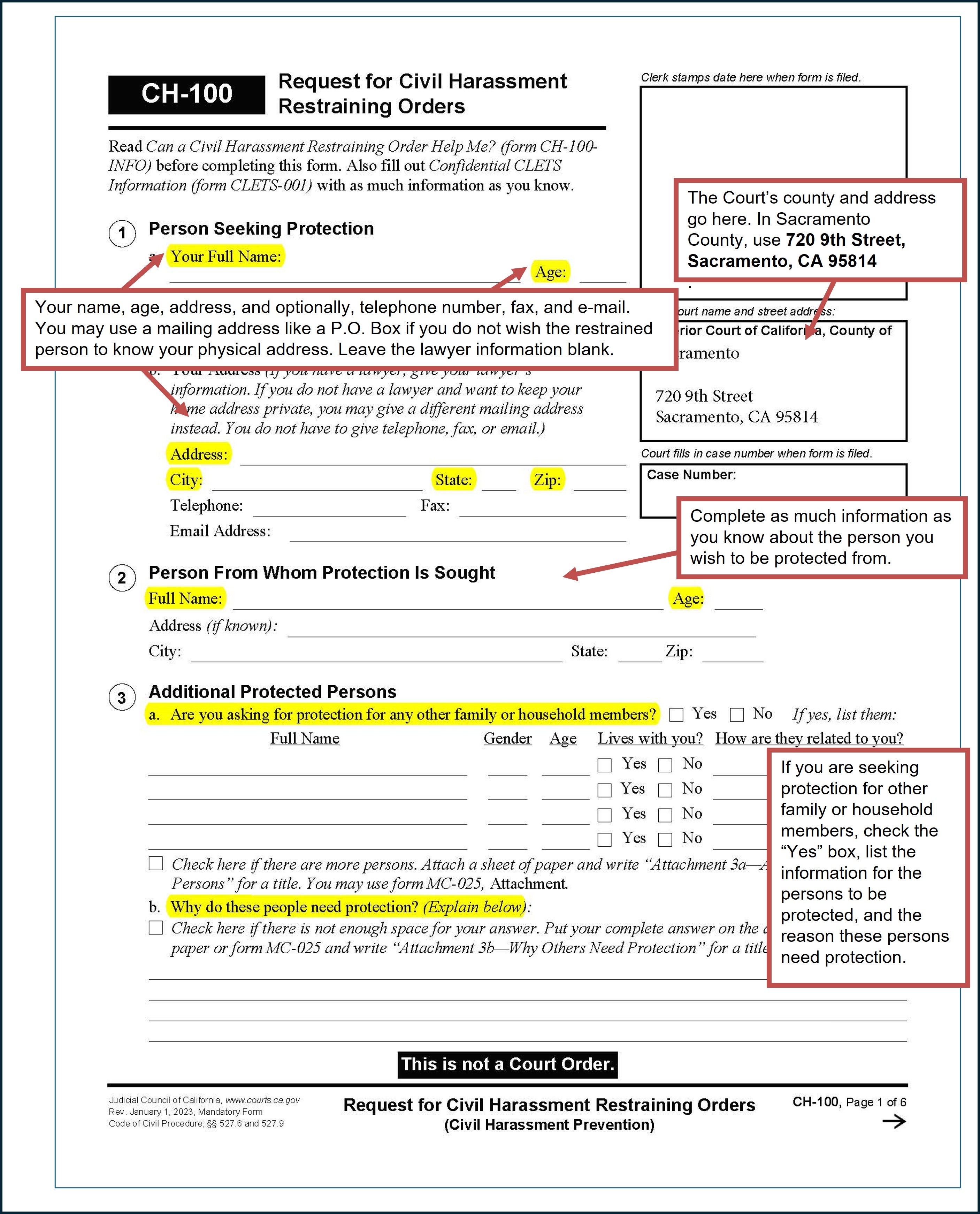
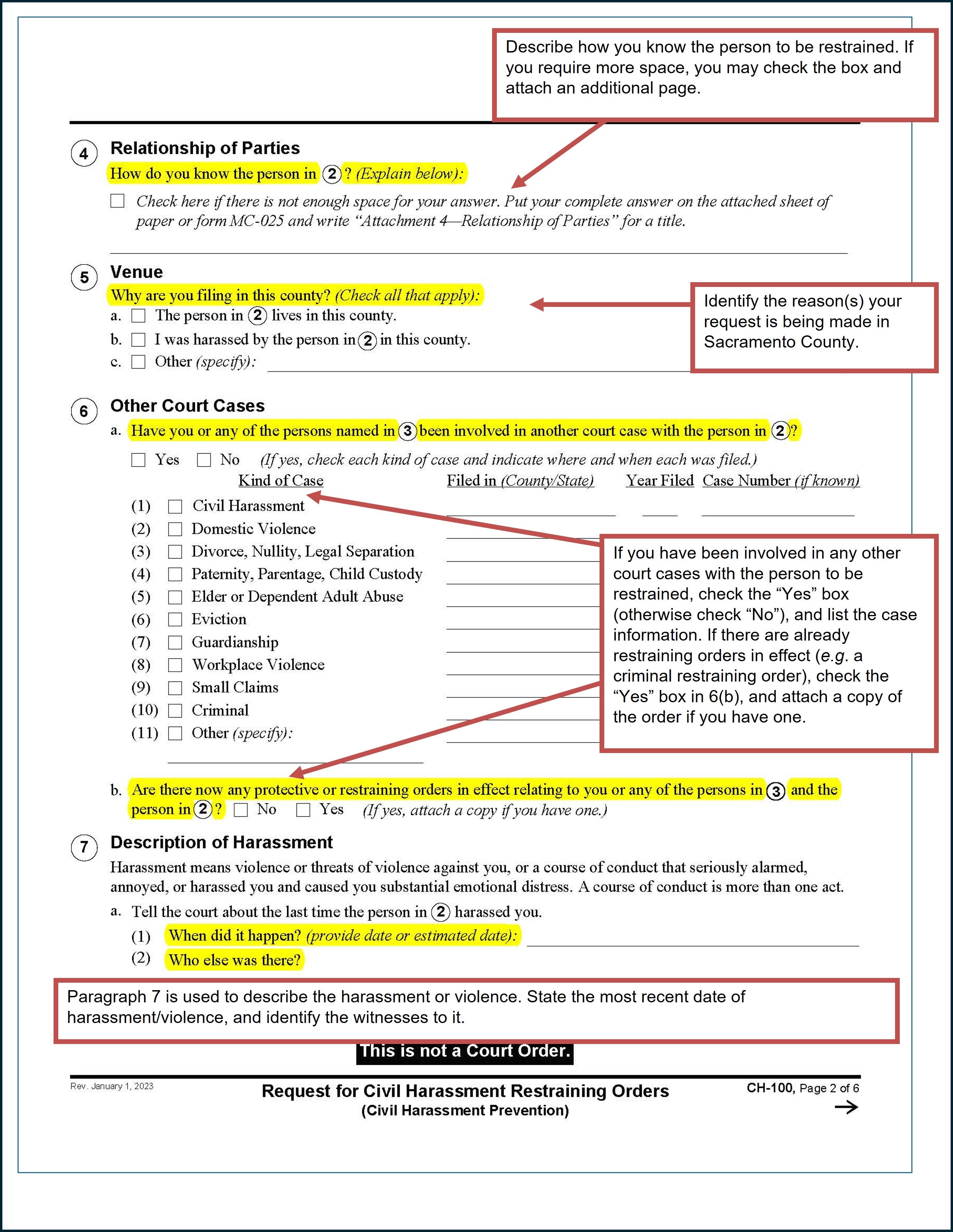
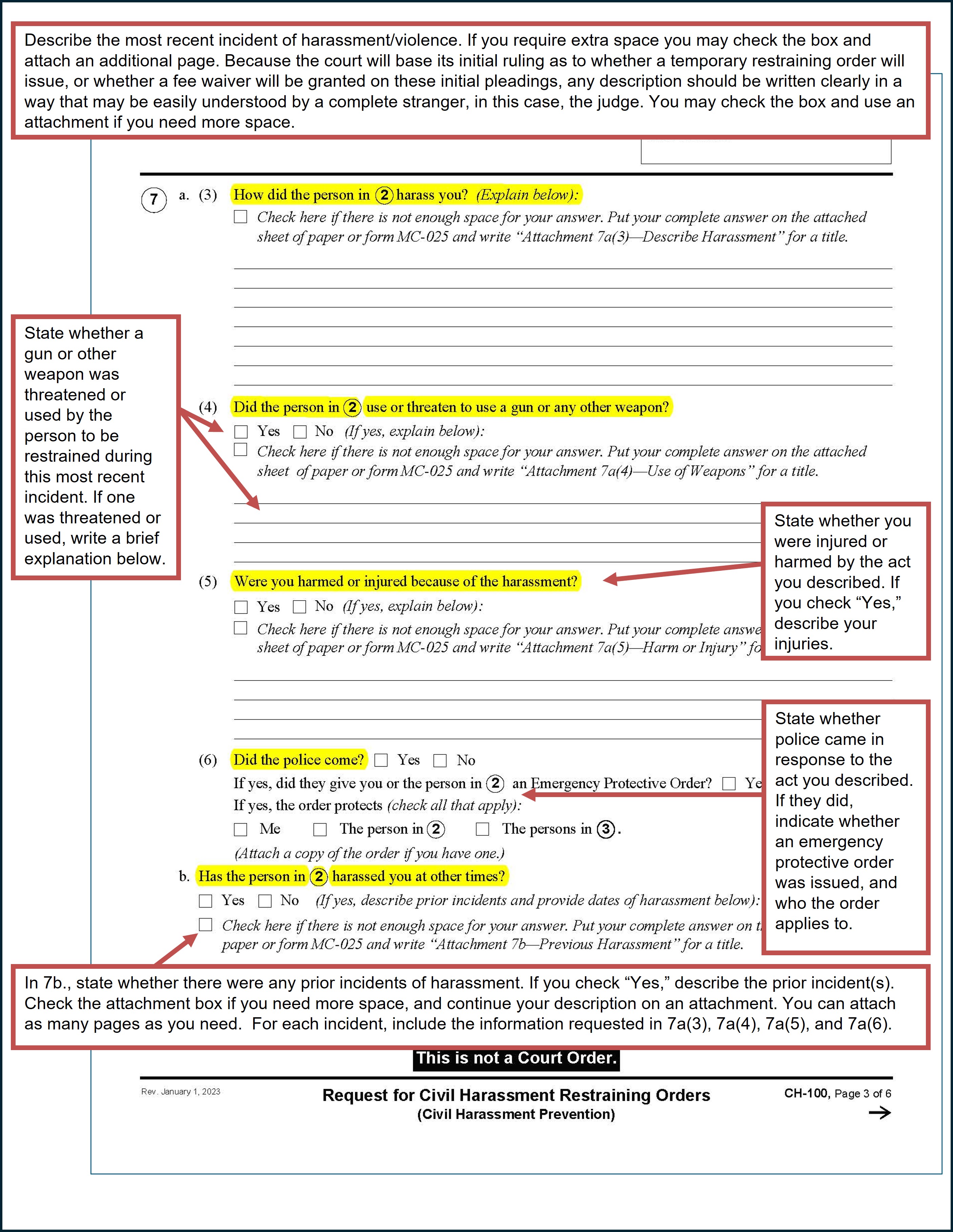
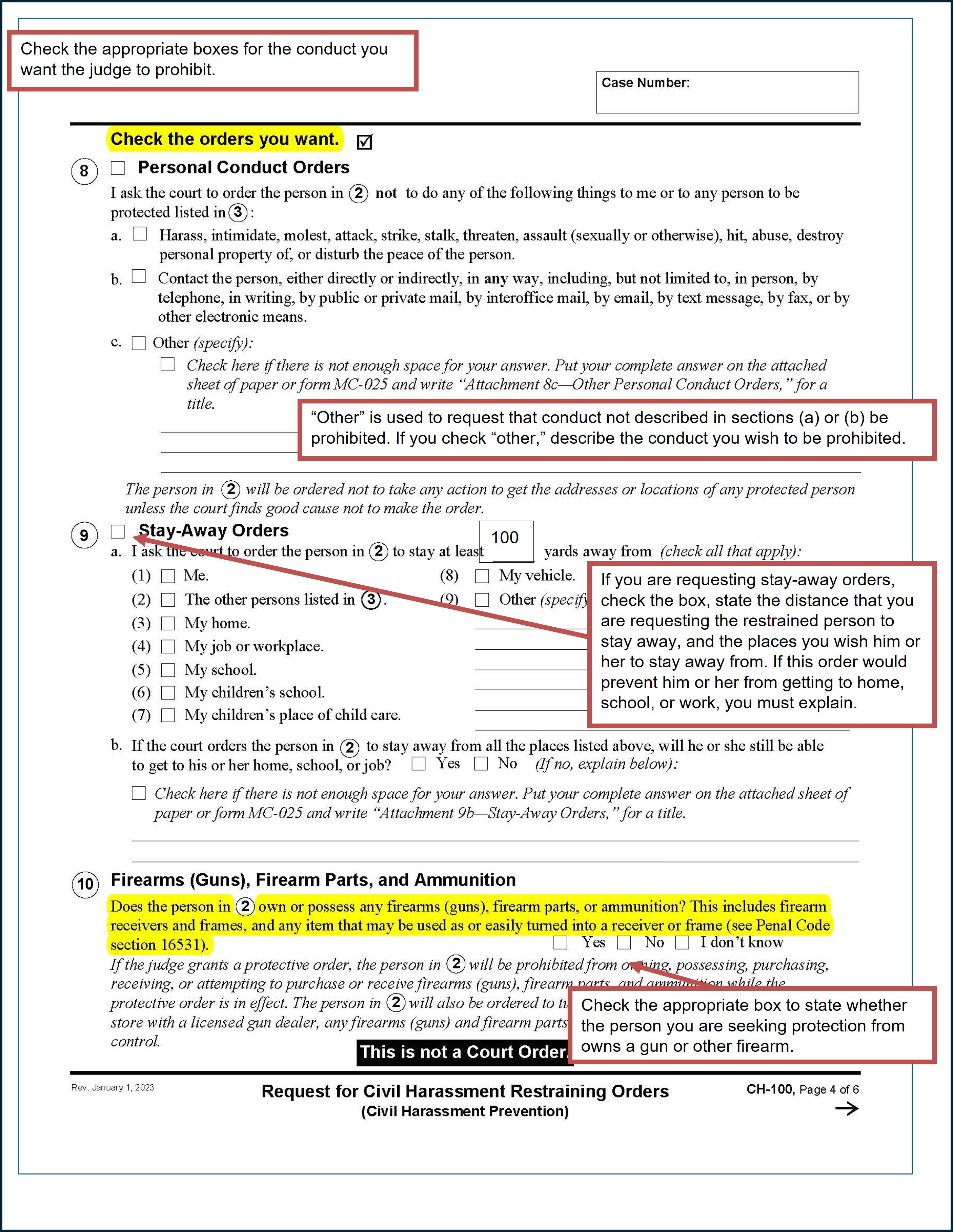
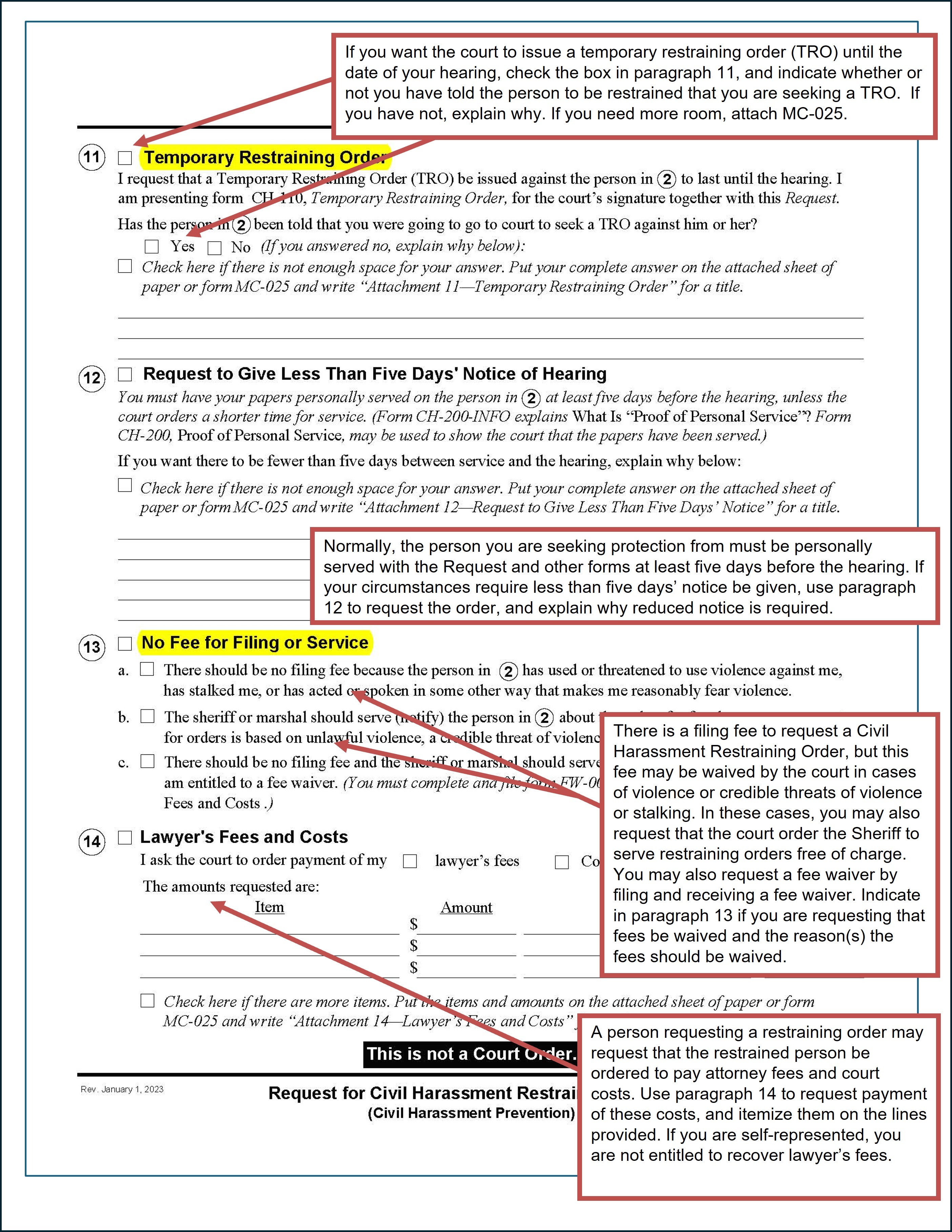
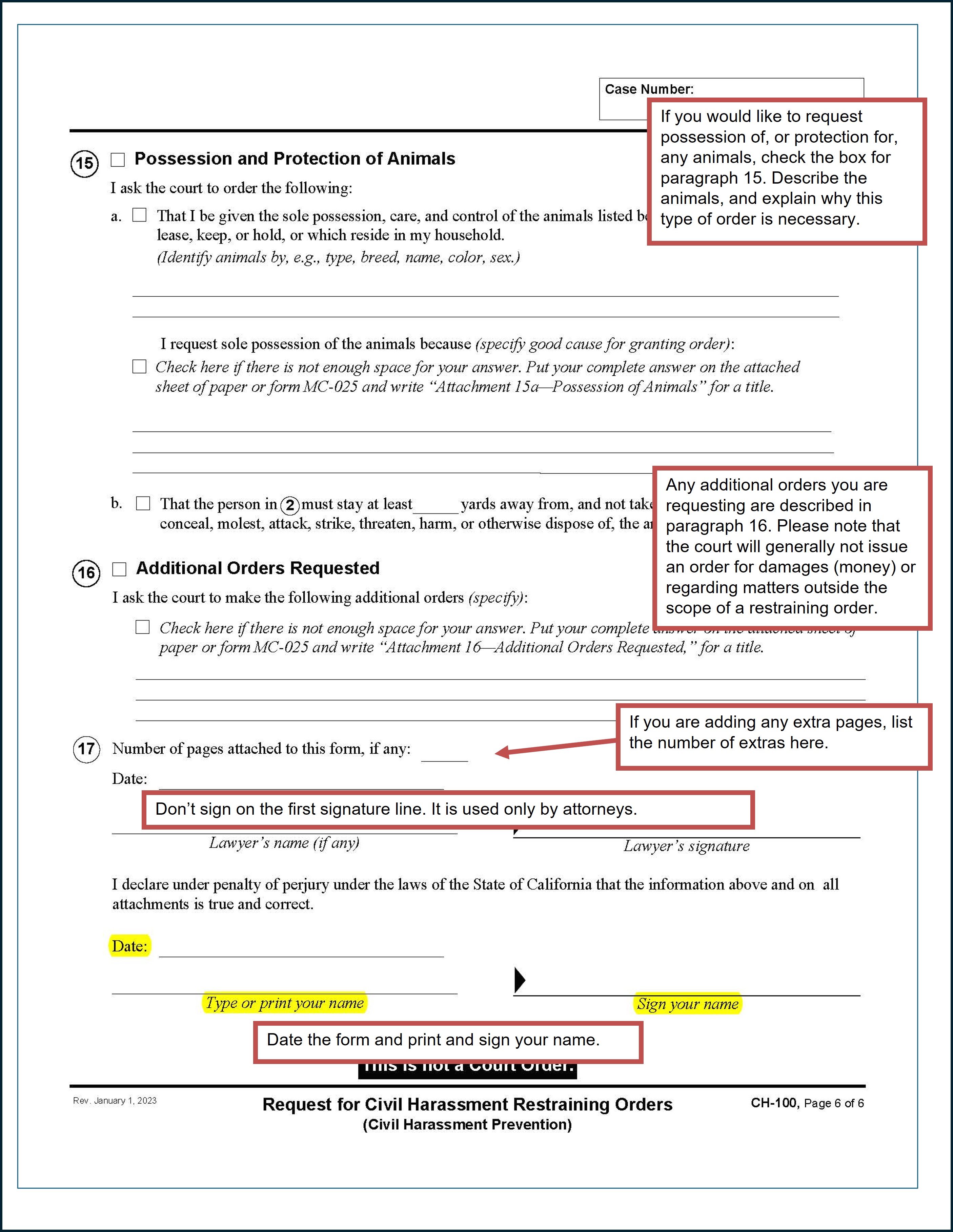
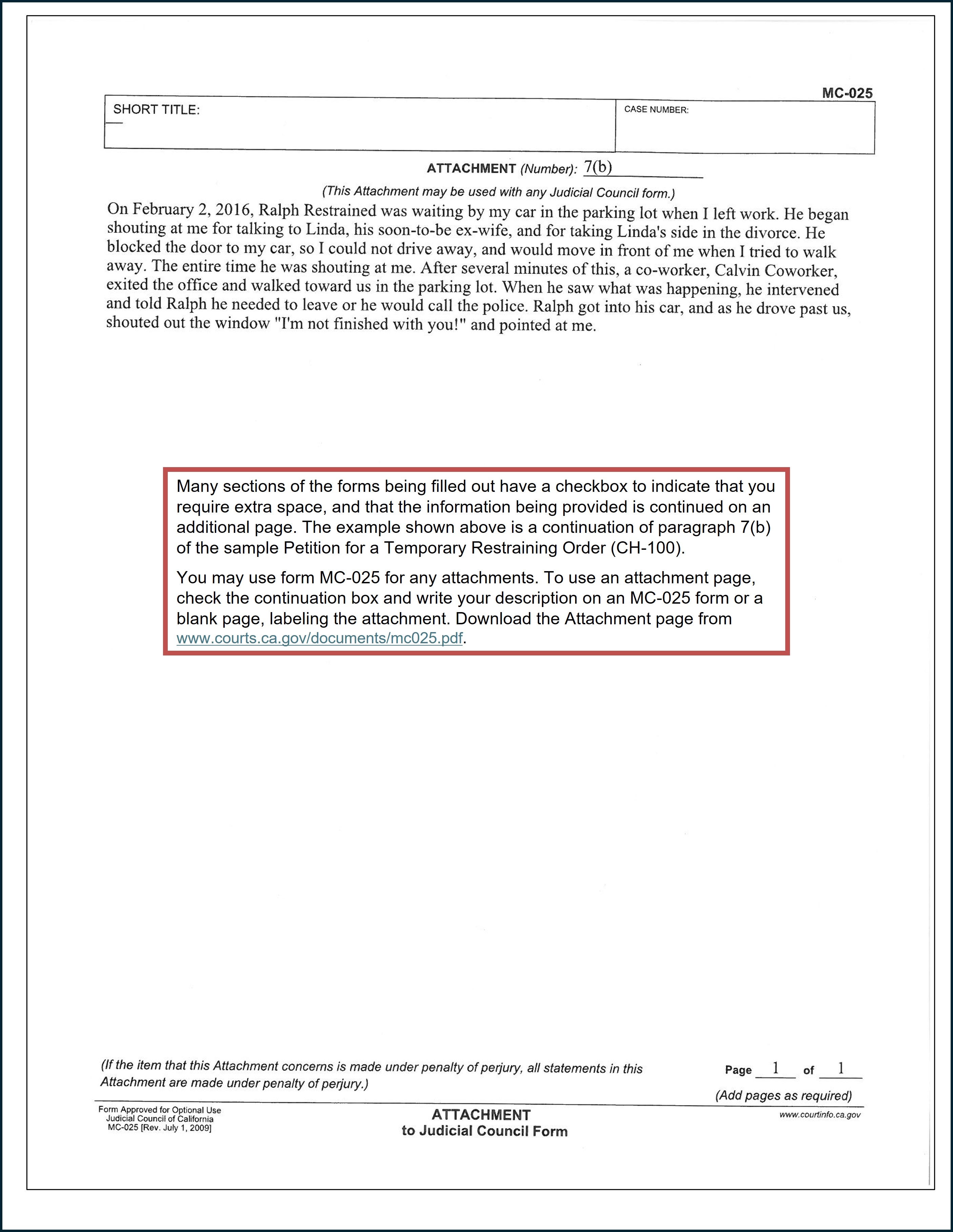
Notice of Court Hearing (CH-109)
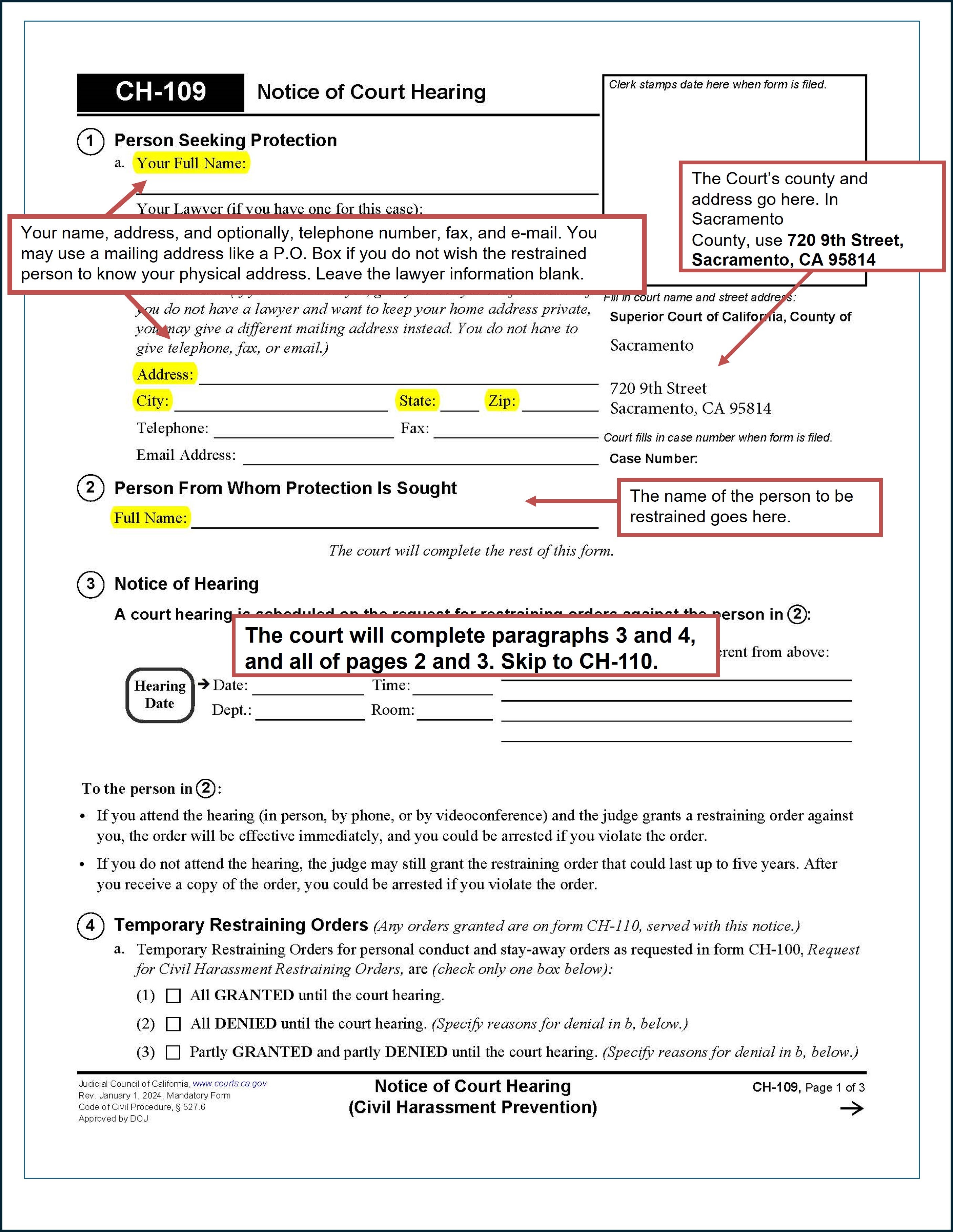
Temporary Restraining Order (CH-110)
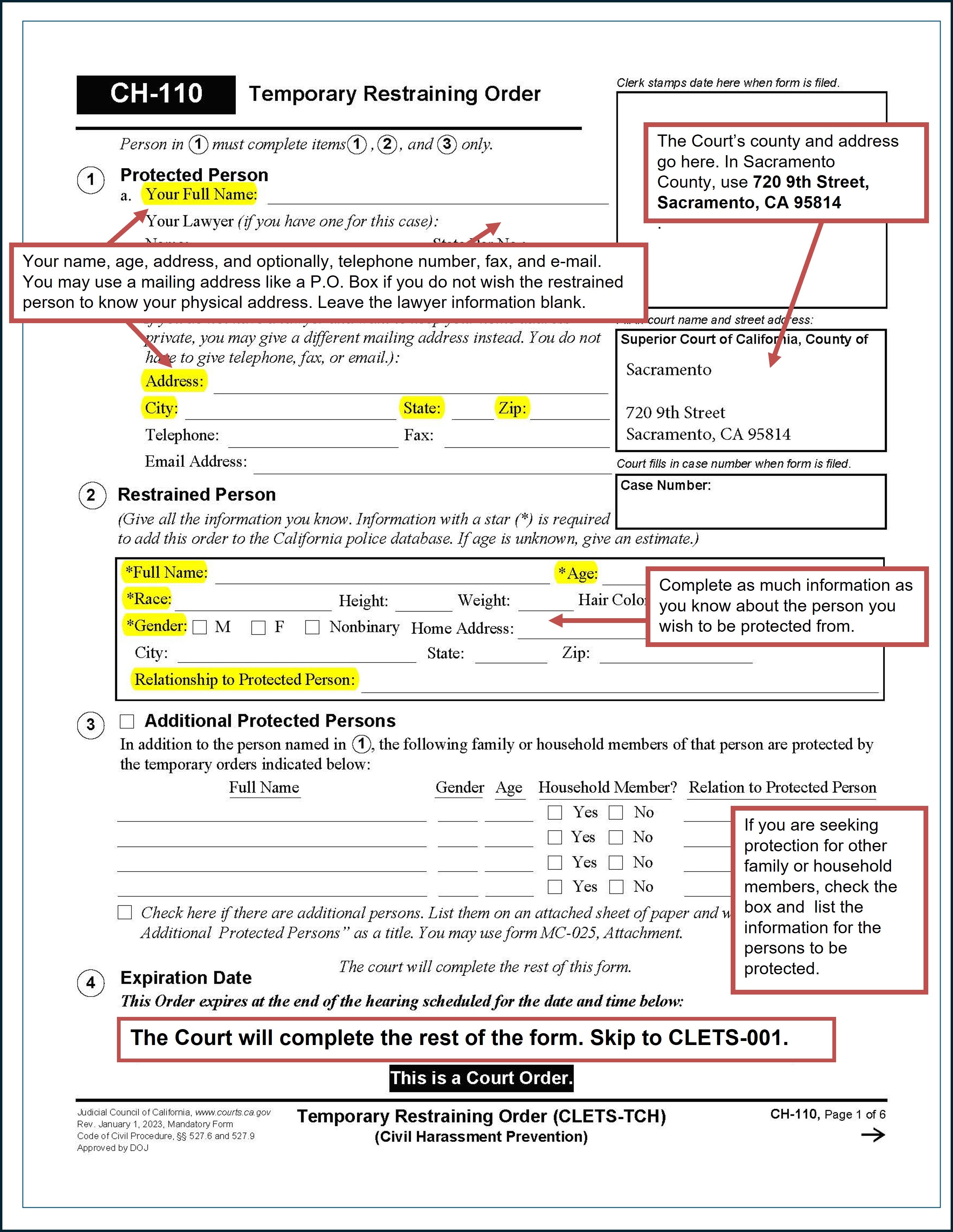
CLETS-001
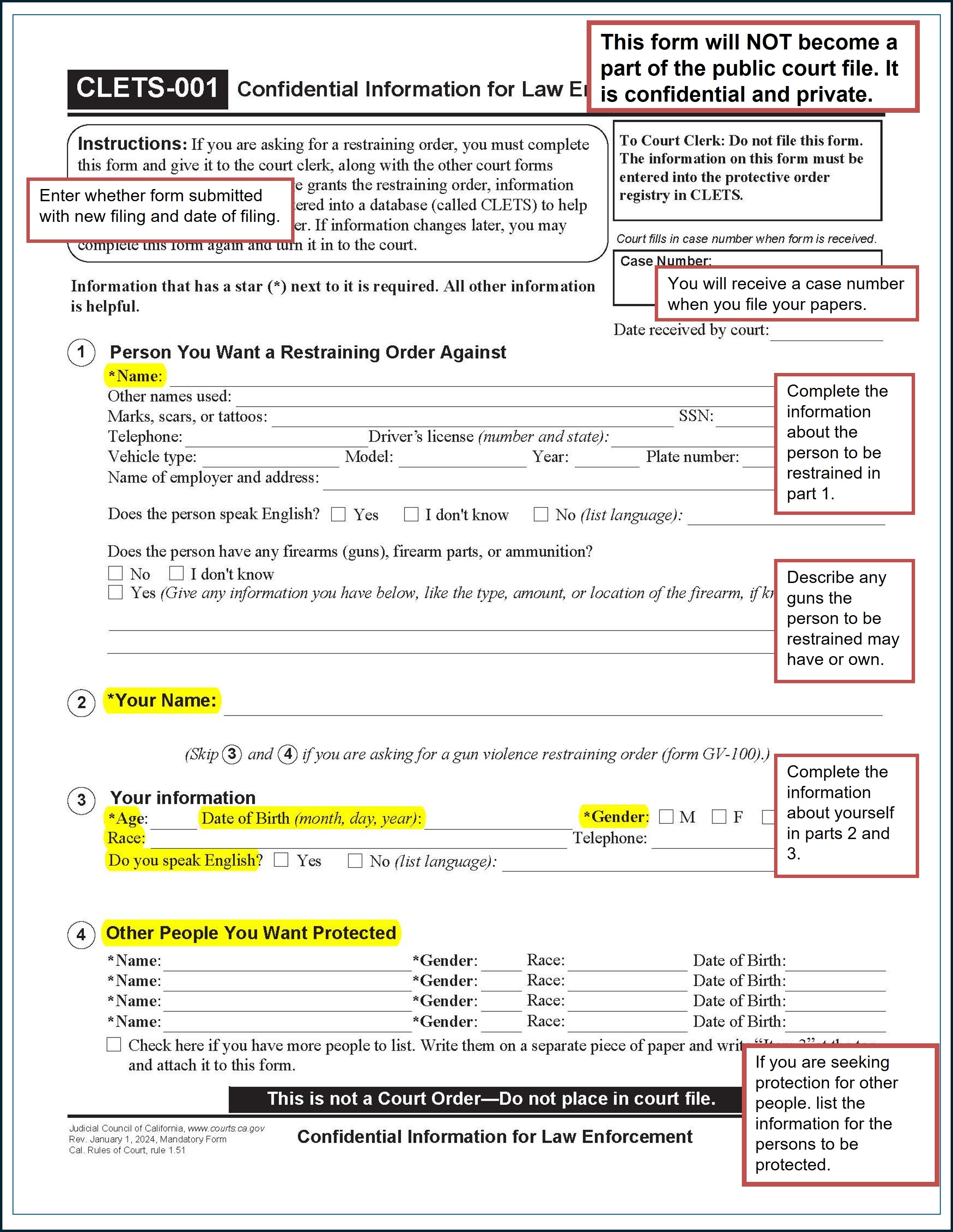
Civil Harassment Restraining Order after Hearing (CH-130)
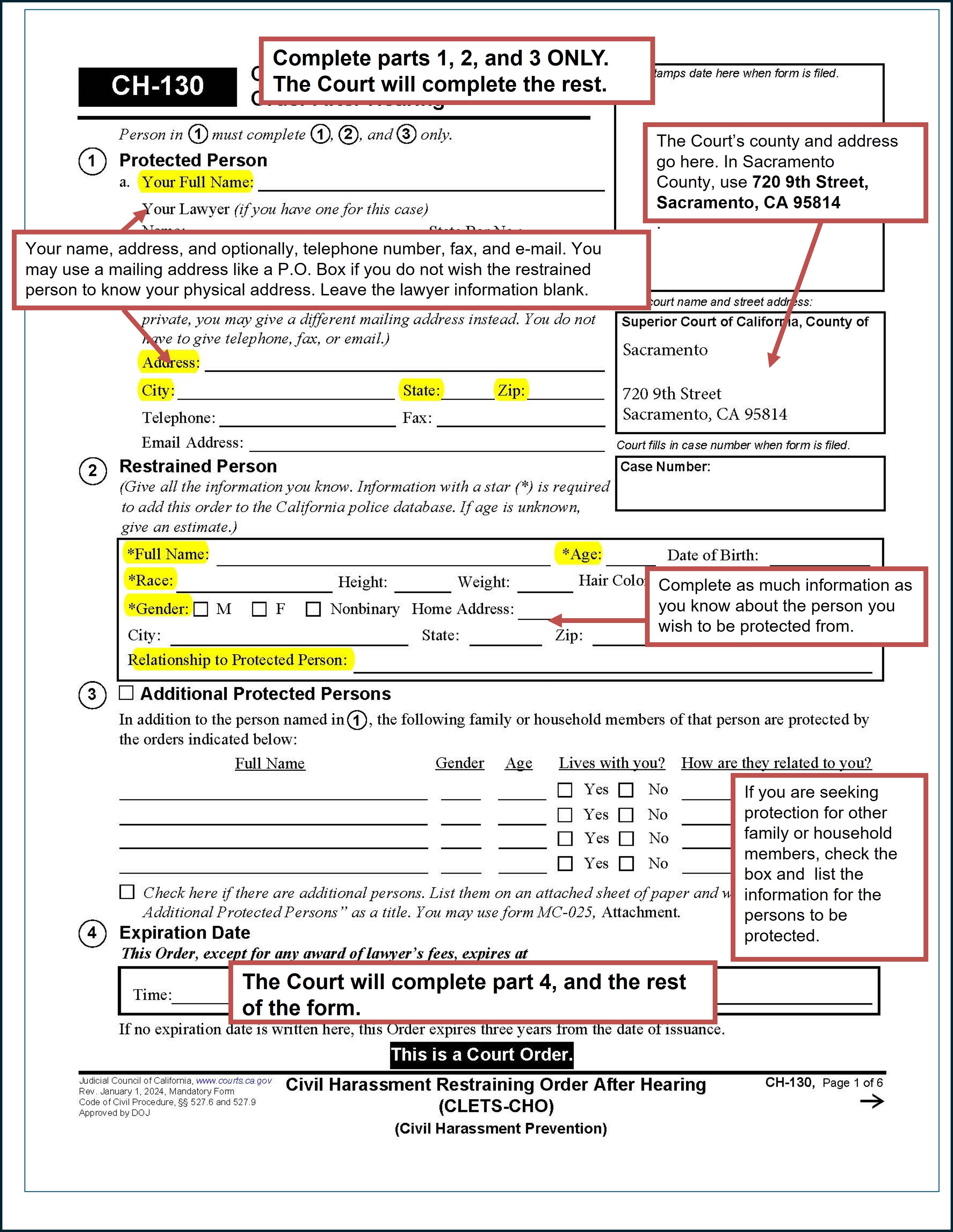
This material is intended as general information only. Your case may have factors requiring different procedures or forms. The information and instructions are provided for use in the Sacramento County Superior Court. Please keep in mind that each court may have different requirements. If you need further assistance consult a lawyer.




